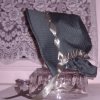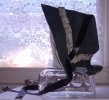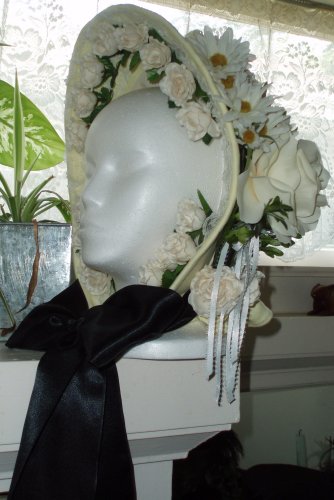|
|
Butterick's B4210 bonnet pattern probably most resembles bonnets
from the mid/late 1850s to mid 1860s, about the time of the
Civil War. Most of these bonnets were made with doubled midweight
buckram and wire and glue, all of which will be defeated by
water. So, no rain or washing for bonnets. If not careful, they crush and wrinkle.
Experiments with heavy interfacing instead of buckram resulted in
bonnets that lost their shape quickly and crushed easily. Steaming/ironing
did not bring back the shape of interfacing bonnets as well as it did with
buckram.
|

|




Yellow cotton over buckram and wire bonnet.
Cotton muslin interior/lining. Interior lace ruffles, artificial flowers,
white satin ribbon on back.
Black satin 4" ribbon ties.
|

|



Black cotton no-wale cotton corderoy over buckram and wire bonnet.
Cotton print interior/lining, white lace on interior brim, and navy blue satin ribbon ties.
|

|

 |

|


Black cotton no-wale cotton corderoy over buckram and wire bonnet.
Cotton print interior/lining, white lace on interior brim, and
black grossgrain ribbon ties. Shown plain and decorated with purchased flowers and
plaid ribbon.
|

|



Dark sage/moss cotton no-wale cotton corderoy over buckram and wire bonnet.
Lighter green cotton interior/lining, green lace on interior brim, and light
green ribbon trim and ties.
|

|

Green upholstery over buckram and wire bonnet.
Cotton print interior/lining. Sage satin ribbon on interior brim, outer trim, and ties.
|

|

Green upholstery over buckram and wire bonnet.
Muslin interior/lining. Interior lace ruffles, purple satin ties.
|

|


Paisley cotton print over heavy interfacing and wire bonnet.
Red taffeta trim and bavolet. Interfacing loses its shape faster than
buckram and is not recommended.
|


